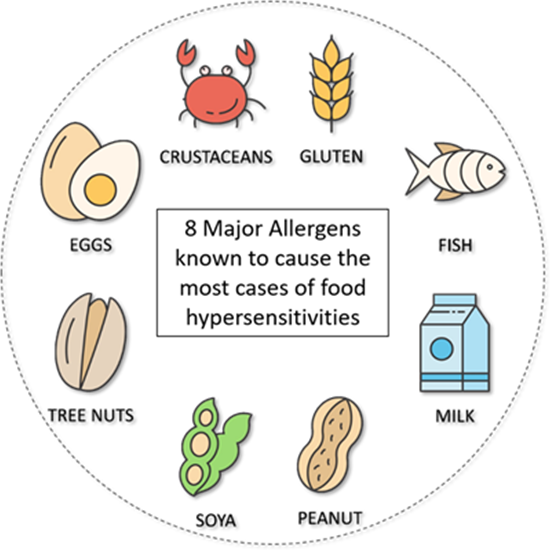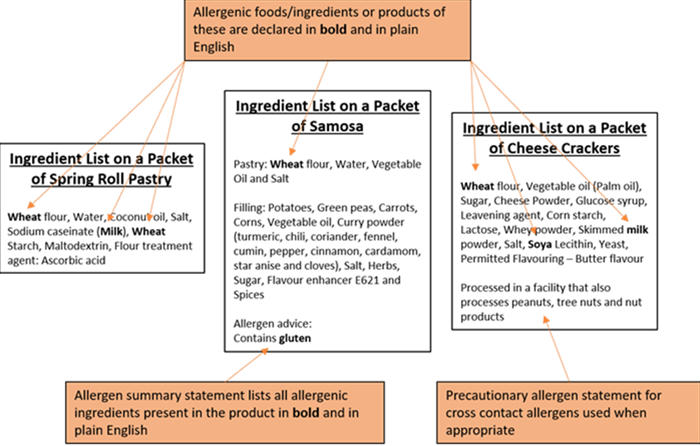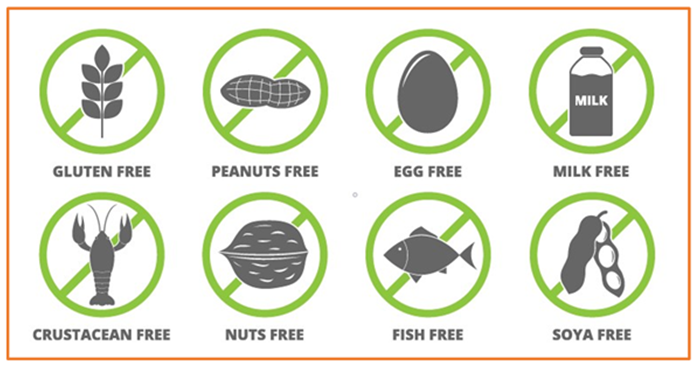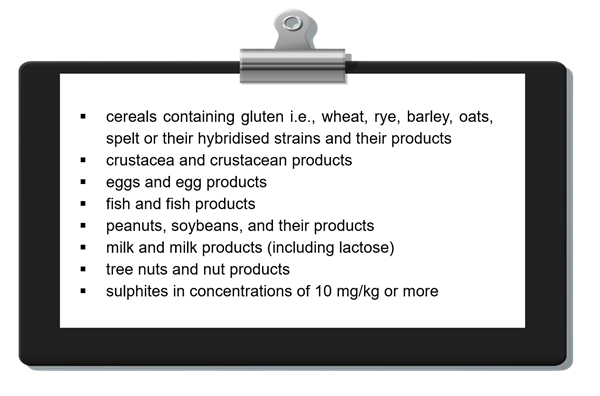Overview
Contents in this page
What are food allergies?
Food allergies occur when our immune system mistakenly identifies a normally harmless food protein as a threat. This triggers an exaggerated response, where the body releases antibodies and chemicals, such as histamine, to combat this perceived 'invader.'
Types of Food Allergies
Symptoms of Food Allergies
How are food intolerances different from food allergies?
Food allergies involve an immune response, while food intolerances arise from the body's inability to digest certain foods. This may be due to a lack of specific digestive enzymes in the body or irritation to the digestive system caused by substances in the food.
Symptoms of food intolerances
What foods cause food allergies and food intolerances?
The 8 Major Classes of Food Allergens
Foods that cause hypersensitivity reactions in people are known as food allergens. Currently, there are more than 170 foods that are known to cause allergic reactions.
Of these, the 8 most common allergens are milk, egg, fish, crustaceans, soya beans, peanuts, tree nuts, and wheat.

The international food standards-setting body, the Codex Alimentarius Commission Committee on Food Labelling, has recommended that these 8 foods be declared on the labels of pre-packaged foods to protect consumers with allergies.
Food components commonly associated with food intolerances
Food components that are commonly associated with food intolerances include:
- Lactose - found in dairy products such as cheese, ice cream, milk chocolates, candies, bread, baked goods, salad dressing, breakfast cereals and cereal bars.
- Gluten - found in bread, cakes, crackers, and certain condiments (e.g. soy sauces, Asian marinades and barbecue sauces), and wheat-based pasta.
- Histamines and amines - found in fermented dairy products such as cheese (especially aged), yogurt, sour cream, buttermilk, fermented vegetables (e.g. sauerkraut, kimchi, pickles and pickled veggies), and cured or fermented meats (e.g. sausages, salami and fermented ham).
- Monosodium glutamate (MSG) - found in snack foods, seasoning for instant noodles, canned soups, and soup mixes, processed meat (e.g. jerky, sausages and smoked meats), frozen meals and condiments.
- Artificial sweeteners - found in soft drinks, candies, puddings, chocolate bars, jams and jellies.
- Galactans - found in legumes such as baked beans, kidney beans, chickpeas and soy-based products.
How can we prevent allergic reactions to food?
The food industry, consumers and government all have a part to play in ensuring food safety. To understand more about how each has a part to play, see:
Industry
What can the industry do to protect consumers?
To ensure consumer safety, the industry plays a vital role in managing food allergens throughout the entire food supply chain and production process.
Cross-contamination can potentially occur at different stages of the supply chain, such as during harvesting, transportation, handling of ingredients, and manufacturing of food products.
To eliminate cross-contact with allergens, a company should also implement the Hazard Analysis Critical Control Point (HACCP), which is an internationally recognised, science-based, and systematic approach to identifying, evaluating, and controlling any biological, chemical, or physical hazards at each stage of the food supply chain.
1. Sourcing of ingredients
2. Storage of ingredients
3. Production scheduling and sanitation
4. Food contact surfaces
5. Cleaning programme
6. Rework and Work-in-Process
7. Employee training
8. Packaging labelling
9. Monitoring and review
Food Labels
How food labels help to prevent food allergies
Requirement to declare
Declaring allergens
Highlighting allergens
Precautionary Allergen Labelling (PAL)
VITAL (Voluntary Incidental Trace Allergen Labelling) Programme
Consumers
How consumers can protect themselves from food allergens
For individuals with food allergies, the best way to prevent an allergic reaction is to avoid consuming food products containing the allergen as an ingredient.
Consumers can also follow the tips below:
- Consumers with food allergies should always check food labels to ensure that the product does not contain the implicated allergen as an ingredient.
- Look out for advisory statements such as ‘May contain [allergen]’ or ‘Produced in a facility that also processes [allergen]’. These are used to address potential cross-contamination with allergen residues. Below are some examples of labels that allergic consumers can look out for:


- Seek immediate medical attention if you experience symptoms of a severe allergic reaction after consuming food.
For more information, you may refer to our Risk at a Glance article on food allergies.
Government
How SFA protects consumers from allergens
SFA’s requirements on food labelling
To protect consumers with food allergies, SFA enforces regulations that require companies to list ingredients on prepacked foods.
Under the Singapore Food Regulations, prepacked food products containing food and ingredients known to cause hypersensitivity must be declared on food packaging labels.

For more information on our labelling requirements, read our Labelling Requirements for Food.
Sampling and testing by SFA
For more information
You can contact us via the SFA Online Feedback Form.


